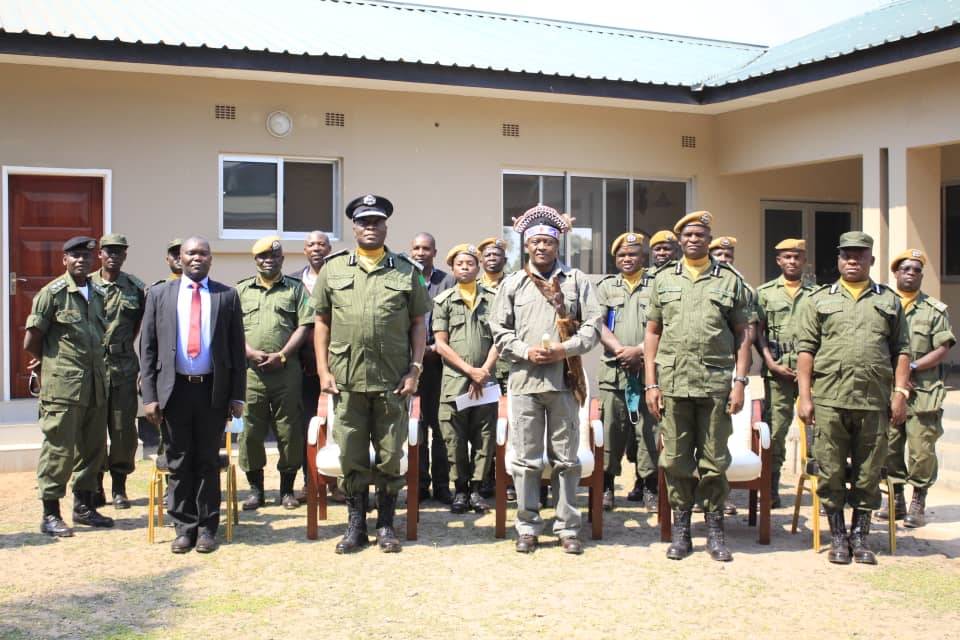Be professional Kakoma Kanganja begs Zambian cops …as Mwata Kazembe XIX Paul Mpemba Kanyembo seeks a peaceful Thursday 17th September 2020 by-election
Notice: Undefined index: catFilterList in /home/zambi/public_html/wp-content/plugins/wp-likes/api.php on line 243

Be professional Kakoma Kanganja begs Zambian cops
…as Mwata Kazembe XIX Paul Mpemba Kanyembo seeks a peaceful Thursday 17th September 2020 by-election

Inspector General of Police Kakoma Kanganja in Luapula eleven days before the Thursday 17th August 2020 parliamentary By-Election occasion by the death of Mwansabombwe MP Rodgers Mwewa – Picture by Zambia Police Public Relations Unit (ZPPRU)
Be professional Kakoma Kanganja begs Zambian cops
…as Mwata Kazembe XIX Paul Mpemba Kanyembo seeks a peaceful Thursday 17th September 2020 by-election
By Zambia Police Public Relations Unit (ZPPRU)
Sunday September 6, 2020
INSPECTOR General of Police, Kakoma KANGANJA has implored Police officers involved in policing elections in Mwansabombwe Constituency to be professional in executing their duties.
Mr. Kanganja cautioned officers against involving themselves in politics saying all those wishing to do so should resign and hand over the Police uniform.
He said the role of the Police is to ensure that law and order prevails as admonished by President Edgar Chagwa Lungu.
“The Head of State has always said that he (Dr. Lungu) does not condone political violence. Be diligent and professional as you discharge your duties,” Mr. Kanganja said.
He advised officers involved in policing elections not to take sides but ensure that the law is applied fairly.
The Inspector General is in the area to check on the security situation and welfare of Police officers in Mwansabombwe District.
And Paramount Chief Mwata Kazembe XIX Paul Mpemba Kanyembo of the Lunda Speaking People of Luapula Province said he will not condone any political violence ahead of the forthcoming coming Parliamentary By- Election.
The traditional leader says Mwansabombwe is a peaceful constituency which all political parties must respect.
He says all political parties taking part in the By- election should conduct only issue based campaigns and not engage in violent activities.
He called on the Police deployed in the area to police the By-election slated for Thursday 17th September, 2020 to ensure peace prevails before, during and after the By election.
He said police presence in the area should not put fear in voters but instill hope for peaceful campaigns and elections.
The traditional leader said this when the Police Chief paid a courtesy call on him today (Sunday 6th September 2020) at his palace in Mwansabobwe.

Kakoma Kanganja in Luapula on Sunday 6th September 2020 – Picture by Zambia Police Public Relations Unit
In one sense, the Lunda society is a set of relationships between established positions, each of which is, at any moment, filled by a person who was one of the members of possible succesors to it. The same names, accordingly, appear throughout the history.
It is convenient to distinguish between names, titles and offices. Names are personal names or nicknames: titles are inherited names, which become at the same time, offices through inheritance. Offices are not personal names. Take for instance Mwata Kazembe Paul Mpemba Kaniembo. Here, Mwata, which is not a personal name, refers to the office of kingship. Mwata means chief, king or husband of everybody. Kazembe is a title: the personal name which has been inherited by each holder of the kingship, the Mwataship. Paul Mpemba Kaniembo is the personal name which distinguishes him from other holders of the position of Mwata Kazembe. Paul was the name he was given at birth, and Kaniembo was the name of his Father.

Be professional Kakoma Kanganja begs Zambian cops
…as Mwata Kazembe XIX Paul Mpemba Kanyembo seeks a peaceful Thursday 17th September 2020 by-election
‘Owners of the land’ to which frequent reference is made in the notes are men who, as their ancestors were before them and their heirs are after them, are responsible for the ritual which ensures the fertility of the small pieces of land they control. When the Lunda arrived, Kazembe created the first overall political organisation of the Luapula Valley and surrounding districts.
Paul Mpemba Kaniembo (Mpalumema) was born on the Tuesday 14th August,1962 in the Palace, Mwansabombwe, Kazembe. His late father was Paul Lutaba Kaniembo who was Mwata Mushindikeni Uwafwa Taishindika Kaniembo XVII. His mother Violet Chanshi is still alive today.
Paul Mpemba Kaniembo started education at Kazembe Primary School in Mwansabombwe in 1969 but progress was disrupted by an illness. But he returned to school later that same year. In 1970 to 1976, Paul was hardly picked for Form 1 as a result.
However, he finally made it to Mwense Secondary School from 1978 to 1983. When his father died in 1983, Paul was taken to the capital city of Zambia, Lusaka by his sister Idah Kaniembo. While in Lusaka, he joined the Ministry of Health. He did Business Studies and Accounting, but then left to join the Zambia National Commercial Bank Ltd, and persued interest in studies with the Association of Accounting Technician. Apart from that, Paul did the Chartered Institute of Bankers Stage 1 in 1990.
What does Mwata Kazembe mean?
The current Mwata
Mwata Kazembe
This is Paul Mpemba Kaniembo eulogised and revered as:
I am a squirrel that can reach or climb to the highest point where no other animal dares and only death can bring me down.
Even if my people cried for me and chose me to be their Mwata, the same people will get tired of me so soon just as people cry for the rains but soon they no longer want it.
I will not hesitate to deal ruthlessly with those, no matter who shall ever attempt to stand in my way as I preside over my people in the same manner the Leopard does to its prey.
This page was last updated: Sunday 5th July, 2015
Mwata Kazembe XIX Paul Mpemba Kanyembo
BACK
Index Events and Times Accommodations History Mwata Kazembe Articles The Palace Places to visit Lunda Hierarchy Photo Gallery
Kazembe Village Directions Mwatas Group Google Earth kmz Wanted Protocol Contact Royal Musicians Items of interest
Mutomboko Ceremony Mission Statement.
He was chosed to be the next Mwata in 1998, at the age of 36. It wa during the Zambian Agricultural and Commercial Show when the Lunda Traditional Hereditory Councillors namely Kalandala Mwana Mwilombe and Diuru Kabeya were sent by the Lunda establishment to get Prince Kaniembo to succeed the late Mwata Kafumbe Chinianta Munona. The messengers had a very difficult time trying to locate Paul. Then when found, as per the Lunda tradition, the elders knelt down before Prince Mpemba Kaniembo and clapped three times then broke the news that he was chosen to become the new Mwata Kazembe of the great Lunda Kingdom. That very moment marked the end of his private life and was asked to lead them to his residence which he reluctantly did to the amazement of the onlookers.
His late father’ clan was Nshimba so he too is Nshimba by clan.
Paul is married to Ema Kapika Kaniembo from Chisenga island in the Democratic Republic of Congo which Mwata appoints its chief and controls. Ema’s mothers’ side is Muyembe, a known Aristocrat in the Lunda Kingdom and her Father is in Kampampi.
Paul has four children born in the Palace. Two girls and two boys.
Mwata Kazembe XIV Chinyanta Nankula or Mwata ‘Tachililwa-kubaya’ was the first Lunda ruler to receive western education. He discontinued the custom that required each Kazembe to build a new house in the palace grounds, by putting up a permanent two-storey house, which he roofed with aluminium sheets. This became the permanent palace for the Mwata and his successors. Unfortunately, he did not live to enjoy the fruits of his labor. He died in October 1950, two days before he was to move into this house.
List of Mwata Kazembes:
1680–1745
I Ng’anga Bilonda—-Years not known
1745–1760
II Kanyembo Mpemba—Years not known 1760–1805
III Lukwesa Ilunga
1805–1850
IV Kanyembo Keleka Mayi (Tchibangu Kanyembo Mayi)
1850–1854
V Kapumba Mwongo Mfwama Kasawo
1854–1862
VI Chinyanta Munona
1862–1870
VII Mwonga Nsemba—1862-1868? (Muonga Sunkutu)
1870–1872
VIII Chinkonkole Kafuti—1868?-1872
1872–1883
IX Lukwesa Mpanga
1883–1885
X Kanyembo Ntemena—?
1885–1886
IX Lukwesa Mpanga
1886–1904
X Kanyembo Ntemena
1904–1919
XI Mwonga Kapakata
1919–1935
XII Chinyanta Kasasa
1936–1941
XIII Chinkonkole
1941–1950
XIV Shadreck Chinyanta Nankula
1951–1957
XV Brown Ngombe Chofwe (Kabumbu)
1957–1961
XVI Kanyembo Kapema
1961–1983
XVII Paul Kanyembo Lutaba (Mushindikeni)
1983–1998
XVIII Munona Chinyanta Kabosha
1998–
XIX Paul Mpemba Kanyembo Kapale Mpalume
The First Palace was in Lunde from 1750-1775 It is now the burial place for all the Mwatas.
This place is forbidden to tresspass on as it is a sacred burial site
The Second Palace was in Shanyembe from 1775-1810.
The Third Palace is at Toka from 1810-1855
The Fourth Palace is at Chomba. From 1855-1885. A 225 meter by 390 meter by 405 meter deep defensive trench was dug around the Palace. This is where David Livingstone met the Mwata in 1867-68. In 1899 the British troops burnt down the Palace for non-compliance
The Fifth Palace is at Mwansabombwe. From 1885 to the present.
MOFWE LAGOON
Lukwesa Mpanga was deposed after short reign in 1862 but returned 10 years later retaining his original title of Mwata Kazembe IX (1872-1886).
Note about the reigns of the Mwatas:
Record keeping was not done therefore we have to rely on oral traditions and different history accounts
Mwata Kazembe XIV
Mwata Kazembe’s Palace today
History of the Lunda Capital and the palace
Since the time of crossing the Luapula river in the 1740, the Lunda Chief, Mwata Kazembe has moved the Palace five times.
Kazembe II Kanyembo, who crossed the Luapula from the DRC around the 1740, and is noted as establishing the first eastern Lunda kingdom. Arox. 20 Kilometers east of the Mofwe Lagoon. He died in Lunde and was buried there creating a royal burial ground for future Mwatas.
The next chief was Kazembe III Lukwesa who succeeded around 1765, and reigned until 1805 in Lunde but later moved it west to Mofwe Lagoon. The site is visible north of the village Shanyemba. The area is 325 ha. enclosed by a ditch which touches the edge of the Luapula and is obvious from the air. This palace was visited by the first Portuguese expedition of Lacerda and Pinto in 1798-1799. This is also confirmed by the slave traders, Baptista and Jose’ in 1806-1810. Then around the 1830s Monterio and Gamitto noted a palace with a defensive trench around it located at Toka, Then David Livingstone visited the Palace in 1867-1868 and described it as having a broad path into a town which had a palace in a reed enclosure 300 meters square, entered by a gateway on which 60 human skulls were mounted. Within the enclosure were huts for Kazembe and for his wives plus other huts for others. This was located near the village of Chomba. There is a rectangular ditch area measuring 225 meters by 390 meters by 405 meters. The ditch is 3 Meters deep. Then after it was burnt down, the capital was moved to Mwasabombwe where it is called Kazembe today.
LUNDE
SHANYEMBECHOMBETOKAMWANSABOMBWE
To the right, This is the only known photo of the original palace that Mwata Kazembe would reside at. The photo was taken in 1951 at the instillation of Mwata Kazembe XV Brown Ngombe Chofwe (Kabumbu). A few days later, he moved into the new palace. Note the thatched roof and wall.
A brick wall surrounds the Palace with a large gate that gives easy access to vehicles. A door into the Palace is guarded by upto 3 body guards which can be accessed by appointment only.
Mwata Kazembe XIV Chinyanta Nankula or Mwata ‘Tachililwa-kubaya’ was the first Lunda ruler to receive western education. He discontinued the custom that required each Kazembe to build a new house in the palace grounds, by putting up a permanent two-storey house, which he roofed with aluminium sheets. This became the permanent palace for the Mwata and his successors. Unfortunately, he did not live to enjoy the fruits of his labor. He died in October 1950, two days before he was to move into this house.
List of Mwata Kazembes:
1680–1745
I Ng’anga Bilonda—-Years not known
1745–1760
II Kanyembo Mpemba—Years not known 1760–1805
III Lukwesa Ilunga
1805–1850
IV Kanyembo Keleka Mayi (Tchibangu Kanyembo Mayi)
1850–1854
V Kapumba Mwongo Mfwama Kasawo
1854–1862
VI Chinyanta Munona
1862–1870
VII Mwonga Nsemba—1862-1868? (Muonga Sunkutu)
1870–1872
VIII Chinkonkole Kafuti—1868?-1872
1872–1883
IX Lukwesa Mpanga
1883–1885
X Kanyembo Ntemena—?
1885–1886
IX Lukwesa Mpanga
1886–1904
X Kanyembo Ntemena
1904–1919
XI Mwonga Kapakata
1919–1935
XII Chinyanta Kasasa
1936–1941
XIII Chinkonkole
1941–1950
XIV Shadreck Chinyanta Nankula
1951–1957
XV Brown Ngombe Chofwe (Kabumbu)
1957–1961
XVI Kanyembo Kapema
1961–1983
XVII Paul Kanyembo Lutaba (Mushindikeni)
1983–1998
XVIII Munona Chinyanta Kabosha
1998–
XIX Paul Mpemba Kanyembo Kapale Mpalume
The First Palace was in Lunde from 1750-1775 It is now the burial place for all the Mwatas.
This place is forbidden to tresspass on as it is a sacred burial site
The Second Palace was in Shanyembe from 1775-1810.
The Third Palace is at Toka from 1810-1855
The Fourth Palace is at Chomba. From 1855-1885. A 225 meter by 390 meter by 405 meter deep defensive trench was dug around the Palace. This is where David Livingstone met the Mwata in 1867-68. In 1899 the British troops burnt down the Palace for non-compliance
The Fifth Palace is at Mwansabombwe. From 1885 to the present.
MOFWE LAGOON
Lukwesa Mpanga was deposed after short reign in 1862 but returned 10 years later retaining his original title of Mwata Kazembe IX (1872-1886).
Note about the reigns of the Mwatas:
Record keeping was not done therefore we have to rely on oral traditions and different history accounts
Mwata Kazembe XIV
Mwata Kazembe’s Palace today
History of the Lunda Capital and the palace
Since the time of crossing the Luapula river in the 1740, the Lunda Chief, Mwata Kazembe has moved the Palace five times.
Kazembe II Kanyembo, who crossed the Luapula from the DRC around the 1740, and is noted as establishing the first eastern Lunda kingdom. Arox. 20 Kilometers east of the Mofwe Lagoon. He died in Lunde and was buried there creating a royal burial ground for future Mwatas.
The next chief was Kazembe III Lukwesa who succeeded around 1765, and reigned until 1805 in Lunde but later moved it west to Mofwe Lagoon. The site is visible north of the village Shanyemba. The area is 325 ha. enclosed by a ditch which touches the edge of the Luapula and is obvious from the air. This palace was visited by the first Portuguese expedition of Lacerda and Pinto in 1798-1799. This is also confirmed by the slave traders, Baptista and Jose’ in 1806-1810. Then around the 1830s Monterio and Gamitto noted a palace with a defensive trench around it located at Toka, Then David Livingstone visited the Palace in 1867-1868 and described it as having a broad path into a town which had a palace in a reed enclosure 300 meters square, entered by a gateway on which 60 human skulls were mounted. Within the enclosure were huts for Kazembe and for his wives plus other huts for others. This was located near the village of Chomba. There is a rectangular ditch area measuring 225 meters by 390 meters by 405 meters. The ditch is 3 Meters deep. Then after it was burnt down, the capital was moved to Mwasabombwe where it is called Kazembe today.
LUNDE
SHANYEMBECHOMBETOKAMWANSABOMBWE
To the right, This is the only known photo of the original palace that Mwata Kazembe would reside at. The photo was taken in 1951 at the instillation of Mwata Kazembe XV Brown Ngombe Chofwe (Kabumbu). A few days later, he moved into the new palace. Note the thatched roof and wall.
A brick wall surrounds the Palace with a large gate that gives easy access to vehicles. A door into the Palace is guarded by upto 3 body guards which can be accessed by appointment only.
1680–1745
I Ng’anga Bilonda—-Years not known
1745–1760
II Kanyembo Mpemba—Years not known 1760–1805
III Lukwesa Ilunga
1805–1850
IV Kanyembo Keleka Mayi (Tchibangu Kanyembo Mayi)
1850–1854
V Kapumba Mwongo Mfwama Kasawo
1854–1862
VI Chinyanta Munona
1862–1870
VII Mwonga Nsemba—1862-1868? (Muonga Sunkutu)
1870–1872
VIII Chinkonkole Kafuti—1868?-1872
1872–1883
IX Lukwesa Mpanga
1883–1885
X Kanyembo Ntemena—?
1885–1886
IX Lukwesa Mpanga
1886–1904
X Kanyembo Ntemena
1904–1919
XI Mwonga Kapakata
1919–1935
XII Chinyanta Kasasa
1936–1941
XIII Chinkonkole
1941–1950
XIV Shadreck Chinyanta Nankula
1951–1957
XV Brown Ngombe Chofwe (Kabumbu)
1957–1961
XVI Kanyembo Kapema
1961–1983
XVII Paul Kanyembo Lutaba (Mushindikeni)
1983–1998
XVIII Munona Chinyanta Kabosha
1998–
XIX Paul Mpemba Kanyembo Kapale Mpalume
Note about the reigns of the Mwatas:
Record keeping was not done therefore we have to rely on oral traditions and different history accounts
LUNDE
MWANSABOMBWE





















